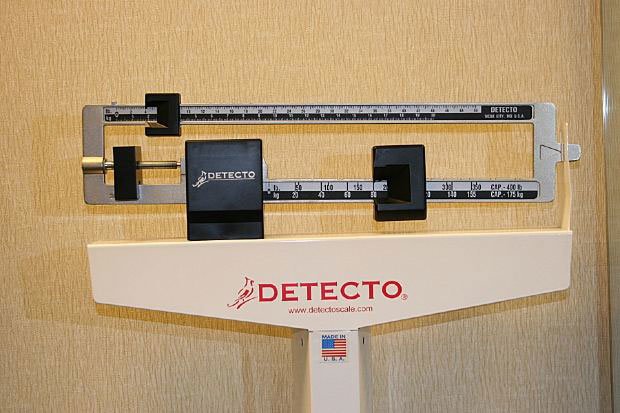Article Summary:
|
Healthy Weight:
It's Not A Diet, It's A Lifestyle!
When it comes to weight loss, there's no lack of fad diets promising fast results. But such diets limit your nutritional intake, can be unhealthy, and tend to fail in the long run.
The key to achieving and maintaining a healthy weight isn't about short-term dietary changes. It's about a lifestyle that includes healthy eating, regular physical activity, and balancing the number of calories you consume with the number of calories your body uses.
Staying in control of your weight contributes to good health now and as you age.
Assess Your Weight
- The first step is to determine whether or not your current weight is healthy. BMI - Body Mass Index is one way to measure your weight. Being in control of your weight contributes to good health now and as you age.
If you've been thinking about your current weight, it may be because you've noticed a change in how your clothes fit. Or maybe you've been told by a health care professional that you have high blood pressure or high cholesterol and that excessive weight could be a contributing factor. The first step is to assess whether or not your current weight is healthy.
How can I tell if I am at a healthy weight?
One way to begin to determine whether your weight is a healthy one is to calculate your "body mass index" (BMI). For most people, BMI is a reliable indicator of body fatness. It is calculated based on your height and weight.
To calculate your BMI, see a BMI Calculator. Or to determine your BMI by calculating your height and weight using the following calculations:
BMI = Weight(kg)/Height(m2) or BMI = 703.1 x Weight(lb)/Height (in2)
- Once you have calculated your BMI this is the BMI Index Chart:
- If your BMI is less than 18.5, it falls within the "underweight" range.
- If your BMI is 18.5 to 24.9, it falls within the "normal" or Healthy Weight range.
- If your BMI is 25.0 to 29.9, it falls within the "overweight" range.
- If your BMI is 30.0 or higher, it falls within the "obese" range.
"Underweight", "normal", "overweight", and "obese" are all labels for ranges of weight. Obese and overweight describe ranges of weight that are greater than what is considered healthy for a given height. while Underweight describes a weight that is lower than what is considered healthy.
If your BMI falls outside of the "normal" or Healthy Weight range, you may want to talk to your doctor or health care provider about how you might achieve a healthier body weight. Obesity and overweight have been shown to shown to increase the likelihood of certain diseases and other health problems, especially if certain other risk factors are present, such as high blood pressure or physical inactivity.
Another way to assess your weight is to measure your waist size. Your waistline may be telling you that you have a higher risk of developing obesity-related conditions if you are:
- A man whose waist circumference is more than 40 inches
- A non-pregnant woman whose waist circumference is more than 35 inches
Excessive abdominal fat is serious because it places you at greater risk for developing obesity-related conditions, such as Type 2 Diabetes, high blood cholesterol, high triglycerides, high blood pressure, and coronary artery disease. Individuals who have excessive abdominal fat should consult with their physicians or other health care providers to develop a plan for losing weight.
How To Measure Your Waist Size: To measure your waist size (circumference), place a tape measure around your bare abdomen just above your hip bone. Be sure that the tape is snug, but does not compress your skin, and is parallel to the floor. Relax, exhale, and measure your waist.
Losing Weight
What is healthy weight loss?
Healthy weight loss isn't just about a "diet" or "program". It's about an ongoing lifestyle that includes long-term changes in daily eating and exercise habits.
It's natural for anyone trying to lose weight to want to lose it very quickly. But evidence shows that people who lose weight gradually and steadily (about 1 to 2 pounds per week) are more successful at keeping weight off. To lose weight, you must use up more calories than you take in. Since one pound equals 3,500 calories, you need to reduce your daily caloric intake by 500-1000 calories to lose about 1 to 2 pounds per week.
Once you've achieved a healthy weight, by relying on healthful eating and physical activity most days of the week (about 60-90 minutes, moderate intensity), you are more likely to be successful at keeping the weight off over the long term. Losing weight is not easy, and it takes commitment.
Preventing Weight Gain
To stay at a healthy weight, it's worth doing a little planning now. If you are overweight but aren't ready to lose weight, preventing further weight gain is a worthy goal.
As people age, their body composition gradually shifts - the proportion of muscle decreases and the proportion of fat increases. This shift slows their metabolism, making it easier to gain weight. In addition, some people become less physically active as they get older, increasing the risk of weight gain.
The good news is that weight gain can be prevented by choosing a lifestyle that includes good eating habits and daily physical activity. By avoiding weight gain, you avoid higher risks of many chronic diseases, such as heart disease, stroke, type 2 diabetes, high blood pressure, osteoarthritis, and some forms of cancer.
If your goal is to prevent weight gain, then you'll want to choose foods that supply you with the appropriate number of calories to maintain your weight. This number varies from person to person. It depends on many factors, including your height, weight, age, sex, and activity level.
Get Moving: In addition to a healthy eating plan, an active lifestyle will help you maintain your weight. By choosing to add more physical activity to your day, you'll increase the amount of calories your body burns. This makes it more likely you'll maintain your weight.
Self Monitoring: You may also find it helpful to weigh yourself on a regular basis. If you see a few pounds creeping on, take the time to examine your lifestyle. With these strategies, you make it more likely that you'll catch small weight gains more quickly.
Ask yourself:
- Has my activity level changed?
- Am I eating more than usual?
You may find it helpful to keep a food diary for a few days to make you more aware of your eating choices.
Balancing Calories
When it comes to maintaining a healthy weight for a lifetime, the bottom line is - calories count! Weight management is all about balance - balancing the number of calories you consume with the number of calories your body uses or "burns off"
- A calorie is defined as a unit of energy supplied by food. A calorie is a calorie regardless of its source. Whether you're eating carbohydrates, fats, sugars, or proteins, all of them contain calories
- Caloric balance is like a scale. To remain in balance and maintain your body weight, the calories consumed (from foods) must be balanced by the calories used (in normal body functions, daily activities, and exercise).
| If You Are... | Your Caloric Balance Status Is... |
| Maintaining Your Weight | "In Balance." You are eating roughly the same number of calories that your body is using. Your weight will remain stable. |
| Gaining Weight | "In Caloric Excess." You are eating more calories than your body is using. You will store these extra calories as fat and you'll gain weight. |
| Losing Weight | "In Caloric Deficit." You are eating fewer calories than you are using. Your body is pulling from its fat storage cells for energy, so your weight is decreasing. |
Healthy Eating For A Healthy Weight
A healthy lifestyle involves many choices. Among them, choosing a balanced diet or eating plan. So how do you choose a healthy eating plan? Let's begin by defining what a healthy eating plan is. According to the Dietary Guidelines for Americans, a healthy eating plan:
- Emphasizes fruits, vegetables, whole grains, and fat-free or low-fat milk and milk products
- Includes lean meats, poultry, fish, beans, eggs, and nuts
- Is low in saturated fats, trans fats, cholesterol, salt (sodium), and added sugars
- Stays within your daily calorie needs




